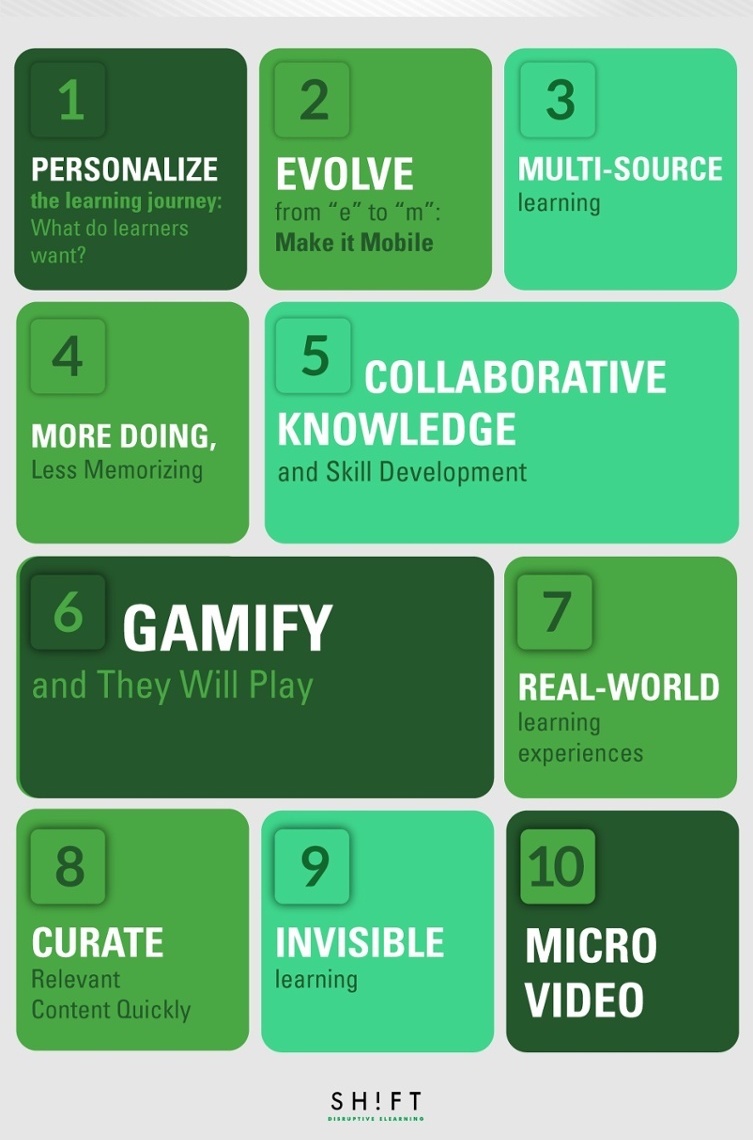As learning leaders, if we want to reduce attrition rates and improve ROI from our training initiatives, we need to get even more creative in capturing our audience’s attention and keeping them engaged. Instead of simply coming up with a course and telling people to take it, we serve ourselves and our audience better by finding ways to inject a learning spirit into the company.
We asked experts in learning and development, eLearning, and human resources to tell us what they think should be the priorities of those creating corporate learning experiences in 2018 and beyond. These are there top 10:

Modern workers are used to being able to access information when and how they want it. This makes the traditional “one size fits all approach” outdated and ineffective. We, as learning leaders, need to concentrate our efforts on providing tools for learners to access content on their own. We need to get up to speed with learner’s expectations, and create eLearning courses that are personalized, and centered on them and their goals.
Things like video, social information sharing, and on-demand courses are becoming the norm along with creating content that helps employees meet their professional goals. Employees know they need skills to advance and they want to feel like the courses they take will help get them there.
New technology is making it easier to create programs that are centered on individual learning plans. Short modules and options to learn when, where and how a person wants to are all attractive to learners and should be incorporated by designers.
Learn more: The Anatomy of a Modern eLearning Course
Today learning can literally happen anywhere now, and a recent study conducted by LinkedIn showed that over half of learners engage at the point of need, meaning at the time they need the information. Others do it during a commute, in their free time or at their desk. Learners are used to being able to access information 24/7, and you need to make your learning programs available in this way too.
To achieve this, we need to leverage the abilities of mobile devices. Taking advantage of mobile interactions like swiping and pinching will also help attract reluctant employees. Learning leaders that adopt a mobile mindset will disrupt and make an impact in their audience.
Along with moving away from a traditional classroom setting, learners are also moving away from traditional teaching aides. Now that things like discussion forums, social media, online video content and even virtual reality are in the mix, eLearning designers can use these to engage learners even more.
Learners will also more readily seek out this kind of content, so instead of pushing it at learners, they will start to pull that information themselves. This is a less formal learning style but also a more effective one for modern learners.
With the massive amounts of information at students’ disposal these days, it has become far less important for them to memorize things and far more important for them to know HOW and WHEN to use the information once they have it. Your eLearning courses should be designed to encourage asking questions, drawing conclusions and developing critical thinking.
Read more: Start Thinking Micro Learning Moments Now
The workforce is more diverse than ever with a much greater range of ages represented in a workspace. Encouraging sharing of knowledge is what will set the modern workplace apart from that of the past. Learning materials that encourage information gathering from peers and mentors will leverage the learning that most of your students are already doing.
Tools like forum discussions, podcasts, collaborative resources like wikis and other interactive means are what will set you courses apart from older, stagnant lessons. If you’re still not convinced, consider that people will still share, learn and complain to each other whether your course has an outlet or not. Giving your learners a constructive way to interact will benefit you and them.
- More Ideas for Social Learning: 23 Getting Social When Social Collaboration Makes Sense
- And 5 Trends in Learning Technology
“87% of employees say that sharing knowledge with their team is critical for learning” Tauber, T. 2015. Investing in Learning Content: Redefining Priorities to Keep Up with the Modern Learner. Bersin by Deloitte, 2015.
What do people like more than learning? That’s right, playing! So, incorporating game elements like rewards and levels into your eLearning course is a good way to get people to engage.
However, it’s more than just making a course more fun. It’s about providing feedback and clear markers of progress. This is something modern learners are far more used to and expectant of than previous generations. All of this adds up to making learning more exciting and engaging which, in turn, makes it more memorable and more likely for students to continue through.
Note: To do this successfully, you have to involve gaming elements judiciously and intelligently. The game aspects shouldn’t overshadow the content itself.
Read more: Before Gamifying eLearning, Read this!
In order to decide what will work for your eLearning courses, look to what consumers are already engaging in. The answer? Experience. Experience is far more important to learners than a single event, and your, course should reflect that.
Digital tools and platforms are making it possible to create a far more immersive learning experience. This is exceptionally true for Virtual Reality technology which is becoming more advanced and more prevalent. The immersive experience of VR allows learners to interact as if they were more of an assistant or apprentice versus a student in a classroom.
This technology is exploding and will continue to grow, becoming more and more relevant for training in the medical field and other jobs that are learned best through hands-on interaction.
eLearning designers are no longer simply developing courses; they are becoming content curators too. Remember your course is in competition with all the other information that the Internet can spew back at your students. Embrace this fact and curate important content to stand up to all the other distractions learners have.
You can’t control learning as you once may have been able to. Your students are not restricted to the information you lay out for them because there are always a million more things they can look at online. To leverage this, you need to pick and choose your content to provide structure and a path to improvement.
Read more:
- Why Should You Adopt Content Curation as an L&D Strategy? (And How to Do It)
- Why We Must Embrace the Consumerization of Learning
Invisible learning, surprisingly, is not a course from Hogwarts, but instead a way of learning that works in the background. Instead of using learning as a separate entity, companies are beginning to treat it as a mindset.
Our growing need and ability to incorporate learning into what workers already do, creates a kind of continuous learning environment where we train the way people think. This makes learning more natural and less tiresome than older ways of learning.
This is part of the evolution that will make learning and working part of each other, versus separate entities. Workers will no longer feel like they are being forced to take time out of work or their personal time to learn because the learning will be automatic and built-in.
As knowledge and networking become more powerful and important, companies should strive to integrate learning with work to create a stronger workforce.
Read more on invisible learning here:
Videos are nothing new in the L&D world, but we’re learning that short videos, specifically, are far more effective than longer ones. Less than a minute is the magic number for learners whose attention spans are as short as their time limits. This forces us to produce more concise and efficient visuals which are a good thing…promise.
